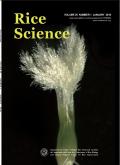Discerning Genes to Deliver Varieties: Enhancing Vegetative- and Reproductive-Stage Flooding Tolerance in Rice
IF 5.6
2区 农林科学
Q1 AGRONOMY
引用次数: 0
Abstract
Flooding in rice fields, especially in coastal regions and low-lying river basins, causes significant devastation to crops. Rice is highly susceptible to prolonged flooding, with a drastic decline in yields if inundation persists for more than 7 d, especially during the reproductive stage. Although the SUB1 QTL, which confers tolerance to complete submergence during the vegetative stage, has been incorporated into breeding programs, the development of alternative sources is crucial. These alternatives would broaden the genetic base, mitigate the influence of the genomic background, and extend the efficacy of SUB1 QTL to withstand longer submergence periods (up to approximately 21 d). Contemporary breeding strategies predominantly target submergence stress at the vegetative stage. However, stagnant flooding (partial submergence of vegetative parts) during the reproductive phase inflicts severe damage on the rice crop, leading to reduced yields, heightened susceptibility to pests and diseases, lodging, and inferior grain quality. The ability to tolerate stagnant flooding can be ascribed to several adaptive traits: accelerated aerenchyma formation, efficient underwater photosynthesis, reduced radial oxygen loss in submerged tissues, reinforced culms, enhanced reactive oxygen species scavenging within cells, dehydration tolerance post-flooding, and resistance to pests and diseases. A thorough investigation of the genetics underlying these traits, coupled with the integration of key alleles into elite genetic backgrounds, can significantly enhance food and income security in flood-prone rice-growing regions, particularly in coastal high-rainfall areas and low-lying river basins. This review aims to delineate an innovative breeding strategy that employs genomic, phenomic, and traditional breeding methodologies to develop rice varieties resilient to various dimensions of flooding stress at both the vegetative and reproductive stages.
识别基因传递品种:提高水稻营养期和生殖期的耐涝性
稻田的洪水,特别是沿海地区和低洼河流流域的洪水,对农作物造成严重破坏。水稻极易受到长时间洪水的影响,如果洪水持续超过7天,特别是在繁殖阶段,产量会急剧下降。虽然SUB1 QTL在营养阶段具有完全浸没的耐受性,已被纳入育种计划,但开发替代来源至关重要。这些替代方案将扩大遗传基础,减轻基因组背景的影响,并延长SUB1 QTL的效力,以承受更长的淹没期(高达约21 d)。当代育种策略主要针对营养阶段的淹没胁迫。然而,在繁殖阶段,停滞的洪水(部分营养部分被淹没)对水稻作物造成严重损害,导致产量下降,易患病虫害、倒伏和粮食质量下降。耐滞水的能力可归因于几个适应特性:加速通气组织的形成,高效的水下光合作用,减少水下组织的径向氧损失,强化茎,增强细胞内活性氧的清除能力,水淹后的脱水耐受性,以及对病虫害的抵抗力。深入研究这些性状的遗传基础,并将关键等位基因整合到精英遗传背景中,可以显著提高洪水易发水稻种植区的粮食和收入安全,特别是在沿海高降雨量地区和低洼河流流域。这篇综述旨在描述一种创新的育种策略,该策略利用基因组学、表型学和传统育种方法,在营养和生殖阶段培育出能够抵御各种洪水胁迫的水稻品种。
本文章由计算机程序翻译,如有差异,请以英文原文为准。
求助全文
约1分钟内获得全文
求助全文
来源期刊

Rice Science
Agricultural and Biological Sciences-Agronomy and Crop Science
CiteScore
8.90
自引率
6.20%
发文量
55
审稿时长
40 weeks
期刊介绍:
Rice Science is an international research journal sponsored by China National Rice Research Institute. It publishes original research papers, review articles, as well as short communications on all aspects of rice sciences in English language. Some of the topics that may be included in each issue are: breeding and genetics, biotechnology, germplasm resources, crop management, pest management, physiology, soil and fertilizer management, ecology, cereal chemistry and post-harvest processing.
 求助内容:
求助内容: 应助结果提醒方式:
应助结果提醒方式:


